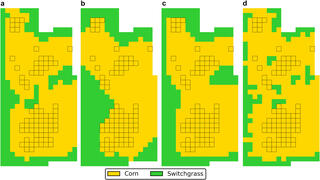Model balances profit, biodiversity, and ecosystem services to guide bioenergy crop layout

Background/Objective
Bioenergy crops such as switchgrass can restore ecosystem services to cropland by limiting erosion, restoring soil carbon, and promoting natural pest control. Decisions about where to plant such crops must balance economic and environmental objectives.
Approach
Great Lakes Bioenergy Research Center scientists developed a mixed-integer quadratically constrained program to optimize the layout of a field-scale cropland considering economic, biodiversity, greenhouse gas emissions, and water quality objectives. Decision variables include spatially varying fertilization in addition to crop establishment location. The model also accounts for biodiversity effects of core area and edges between crops.
Results
Researchers applied the model to an example field, demonstrating tradeoffs between maximizing profit and environmental objectives. Planting switchgrass or prairie in place of corn increases biodiversity, GHG sequestration, and water quality simultaneously, though by different amounts and with potentially large negative impacts on profit. However, there are solutions where switchgrass is planted in areas with low corn yield that are better than planting and fertilizing corn in all cells (the status quo) for each of the four objectives.
Significance
The model demonstrates the importance of measuring and optimizing multiple objectives at the sub-field, field, and landscape scale to achieve better outcomes for all competing objectives. Precise values and benefits depend on field-specific variables such as soil, weather conditions, yields, and input rates, so high-quality data are critical for real-world application.
Geissler, C. H. et al. A multi-objective optimization model for cropland design considering profit, biodiversity, and ecosystem services. Ecological Modelling, 500, 110954. (2025). [DOI:10.1016/j.ecolmodel.2024.110954